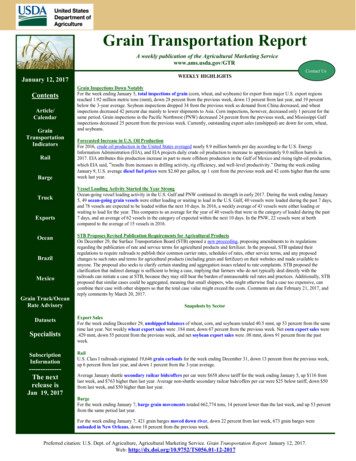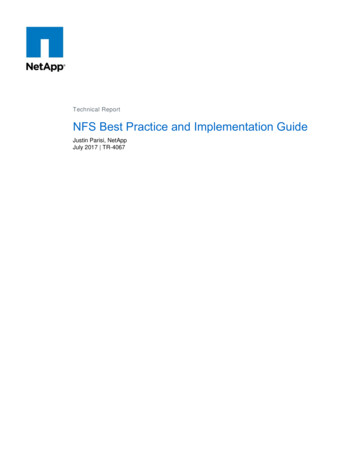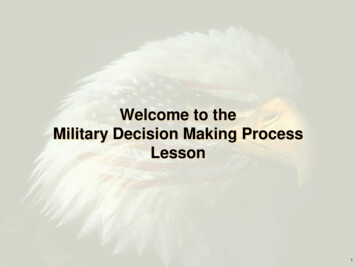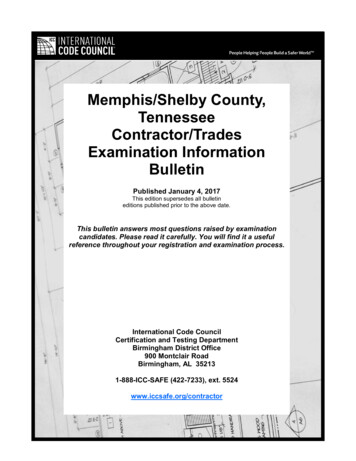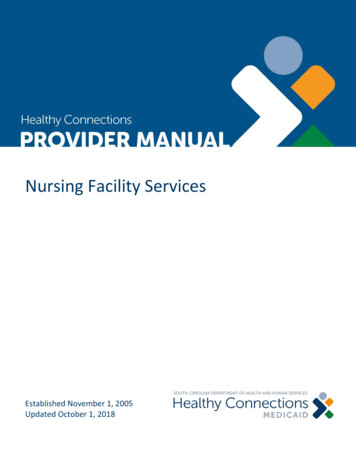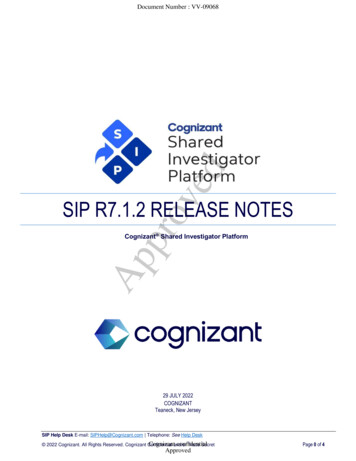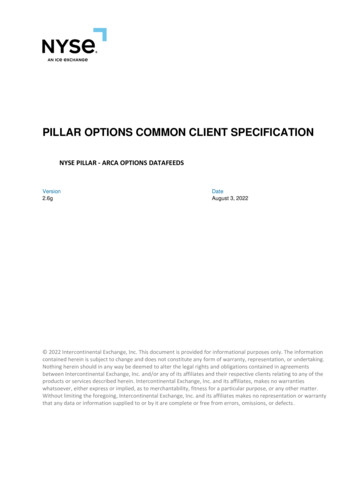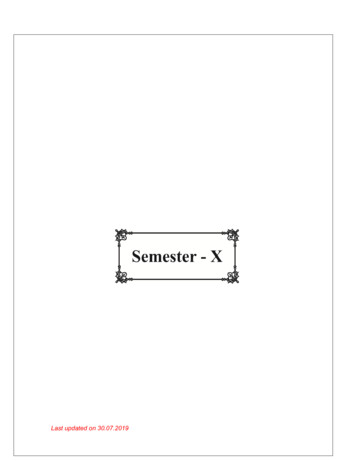
Transcription
Last updated on 30.07.2019
FACULTY OF LAWINSURANCE, BANKING & NEGOTIABLE INSTRUMENT(The entire syllabus is divided into five units. Ten questions shall be set in all with twoquestions from each unit. The candidate shall be required to answer five questions in allselecting one from each unit.)Objective: Insurance is a form of risk management used to hedge against the risk ofa contingent loss. The operational framework of insurance idea is provided by thegeneral principles of contract. The insurance policy, being a contract, is subject to allthe judicial interpretative techniques of rules of interpretation as propounded by thejudiciary. Besides, the insurance idea has a compensatory justice component. Thiscourse is designed to acquaint the students with the conceptual and operationalparameters of insurance law.UNIT-IINSURANCE-I Nature and Principles of Insurance: Definition-Kinds-Statutory Governance Contract of Insurance: Nature-Essential Features-Types Fundamental Principles of Insurance ContractUNIT-IIINSURANCE- II Insurable Interest Premium RiskUNIT- IIINEGOTIABLE INSTRUMENTS Concept, Meaning and Kinds of Negotiable Instruments.2
B.A.LL.B. (Hons.) Semester-X Some General Terms Used for All Types of Negotiable Instruments: inlandand Foreign Instruments, Time and Demand Instruments, AmbiguousInstruments, Inchoate Instruments, Escrow Instruments, Maturity ofInstruments, Payment in Due Course, and Payment of Interest. Liabilities of Parties to Negotiable Instruments.UNIT-IVNEGOTIABLE INSTRUMENTS Presentation of Negotiable Instruments Negotiation of Negotiable Instruments Dishonour and Discharge of Negotiable InstrumentsUNIT-VBANKING Banking: Meaning and History, Concept of Banking Companies. Concept of Customer, Banks and Customers Relations. Customers Accountand Banks. Banks Funding -Loans and Advances as means of. Banking Ombudsman.Suggested Readings:1. Herbert P. Sheldon: Practice and Law of Banking, Macdonald & Evans Ltd., UnitedKingdom.2. Lord Chorley and P. E. Smart: Leading Case in the Law of Banking, Bharat LawHouse, New Delhi.3. L. C. Goyle: Law of Banking and Bankers, Eastern Law House, New Delhi.4. M. L. Tannan (revised by C. R. Datta & S. K. Kataria): Banking Law and Practice,LexisNexis India, Gurgaon.3
FACULTY OF LAW5. A. B. Srivastava and K. Elumalai: Seth’s Banking Law, Law Publisher’s India (P)Limited, Allahabad.6. R. K. Gupta: Banking: Law and Practice, Modern Law Publications, Allahabad.7. Prof. Clifford Gomez: Banking and Finance-Theory, Law and Practice, PHI LearningPrivate Limited, New Delhi.8. J. M. Holden: The Law and Practice of Banking, Universal Law Publishing,Allahabad.9. K. S. N. Murthy and K. V. S. Sarma: Modern Law of Insurance in India, LexisNexisIndia, Gurgaon.10. Sachin Rastogi: Insurance Law and Principles, LexisNexis, India Gurgaon.4
B.A.LL.B. (Hons.) Semester-XCONFLICT OF LAWS(The entire syllabus is divided into five units. Ten questions shall be set in all with twoquestions from each unit. The candidate shall be required to answer five questions in allselecting one from each unit.)OBJECTIVE: This branch of law comes into picture whenever a court or tribunal isfaced with a conflict between two laws and the court has to decide which law itshould apply. The aim of the paper is to create an understanding of the rules ofconflict of laws under various legal systems pertaining to jurisdiction, marriage,divorce, and adoption. The paper also covers torts and contract laws. Further, thepaper discusses recognition and enforcement of foreign judgments.UNIT-IINTRODUCTION Introduction to Conflict of Laws, envoi, Characterisation Domicile: Meaning & General Rules-Kinds of Domicile: Domicile of OriginDomicile of Choice-Domicile of Dependents-Domicile & Nationality Marriage: Nature-Concept-Governing Law-Choice between Law of the Placeof Celebration and Law of Domicile-Validity of Marriage Classification ofRules of Marriage into Formal and Essential Conditions Theories: Dual Domicile Theory-Intended Matrimonial Home TheoryAlternate Approaches-Polygamous MarriagesUNIT-IICONFLICT OF LAWS IN RELATION TO MATRIMONIAL REMEDIES Nullity of Marriage Restitution of Conjugal Rights Judicial Separation Dissolution of Marriage-Recognition of Foreign Divorce5
FACULTY OF LAWUNIT IIICONFLICT OF LAWS IN RELATION TO CONVERSION, LEGITIMACY &LEGITIMATION Conflict of Laws in relation to Conversion Effect of Conversion on Matrimonial Rights Effect of Conversion on Dissolution of Marriage Legitimacy & LegitimationUNIT-IVCONFLICT OF LAWS IN RELATION TO ADOPTION & GUARDIANSHIP Conflict of Laws in Relation to Adoption: Jurisdiction-Recognition of ForeignAdoptions Inter-Country Adoption Conflict of Laws in Relation to Guardianship and Custody of Minors Recognition and Enforcement of Foreign Judgments-Child Custody andGuardianship Orders-Child AbductionUNIT-VCONFLICT OF LAWS IN RELATION TO CONTRACT AND TORTS Concept and Application of Contract in Private International Law Validity of Contract-Material Validity-Formal Validity Capacity to Contract-Discharge of Contract Foreign Torts-Traditional Theories-Torts in Private International LawSuggested Readings1. Atul M Setalvad: Setalvad’s Conflict of Laws, LexisNexis, New Delhi.2. Chris Clarkson & Jonathan Hill, Conflict of Laws, Oxford University PressCanada.3. David Pearl: Inter-Personal Conflict of Law- India, Pakistan and Bangladesh, N.M.Tripathi, Bombay.6
B.A.LL.B. (Hons.) Semester-X4. Flavia Agnes, Family Law and Constitutional Claims, Oxford University Press, NewDelhi.5. Geoffrey Chevalier Cheshire: Private International Law, Clarendon Press, Oxford.6. J. H. C. Morris: Conflict of Laws, Sweet & Maxwell, London.7. John P. Tiernan: Conflict of Laws, Callaghan & Co, Chicago.8. Kumud Desai, Indian Law of Marriage and Divorce, LexisNexis, Gurgaon.9. Laura E. Little: Conflict of Laws, Wolters Kluwer Law & Business, New York10. Paras Diwan: Indian and English Private International Law, Deep & Deep, NewDelhi.11. Robert A. Leflar: The Law of Conflict of Law, The Bobbs-Merrill Company, Inc.,Indianapolis.12. Dean Symeon C. Symeonides: Choice of Law, Oxford University Press, USA.13. Maebh Harding: Conflict of Law, Routledge, UK.Case Laws1. Anokha v. State of Rajasthan, AIR 2004 SC 2829.2. Apt v Apt, [1948] P. 83.3. Arathi Bandi v. Bandi Jagdrakshara Rao, AIR 2014 SC 918.4. Armitrage v Att-Gen, [1906] p. 135.5. Bell v Kennedy, (1868) LR 1 Sc & Div 307.6. Berkovits v Grinberg, [1995] fam. 142.7. Berthiaume v Dastous, [1930] AC 79.8. Boys v Chaplin, [1971] AC 3569. Central Bank of India v. Ram Narain, AIR 1955 SC 3610. Chaudhary v Chaudhary, [1985] Fam. 19.11. D & D, [2008] EWHC 403 (Fam).12. D P Joshi v. State of Madhya Bharat, AIR 1955 SC 334.13. Hussain v Hussain, [1983] Fam. 26.7
FACULTY OF LAW14. Hyde v Hyde (1866) LR 1 P & M 130.15. Indyka v. Indyka, (1967) 2 All. E.R. 689.16. Kyle Spencer Allen v. Soban Singh, 2014(3) UC 2335.17. Lakshmi Kant Pandey v. Union of India, AIR 1984 SC 469.18. Le Mesurier v Le Mesurier, [1895] AC 517.19. Louis De Raedt v. Union of India, AIR 1991 (3) SC 1886.20. May v May, [1943] 2 All ER 146.21. McCabe v McCabe, [1994] 1 FLR 410.22. McKee v. McKee, [1950] SCR 700.23. MN (Non-Recognised Adoptions: Unlawful Discrimination?) India, UKAIT 00015.24. Mrs. M v. Mr. A, AIR 1993 Bom. 110.25. Narsimha Rao Y. v. Venkata Lakshmi Y, (1991) 3 SCC 451.26. Neha Saini v State of Uttrakhand, AIR 2010 Utt 36.27. Ogden v. Ogden, (1947) All E.R. 86.28. Perumal v. Ponnuswami, AIR 1971 SC 2352.29. Philips v Eyre, (1870) LR 6 QB.30. Pradeep Jain v Union of India, AIR 1984 SC 1420.31. Prem Singh v. Dulari Bai, AIR 1973 Cal. 425.32. Pugh v Pugh, [1951] P 482.33. Quazi v Quazi, [1980] AC 744.34. Ramsay v Liverpool Royal Infirmary, [1930] AC 588.35. Ravichandran v. Union of India, AIR 2010 SC (Supp) 257.36. Re. Evans, [1947] Ch. 69537. Re. Jones’ Estate, 192 Iowa 78.38. Reynold Rajamani v Union of India, AIR 1982 SC 1261.39. Robasa Khanum v. Khudabad Bomanji Irani, AIR 1947 Bom. 272.40. Ruchi Majoo v. Sanjeev Majoo, AIR 2011 SC 1952.8
B.A.LL.B. (Hons.) Semester-X41. Sandip Shankerlal Kedia v. Pooja Kedia, 2013 (4) Mh Lj 673.42. Sanjay Mishra v. Eveline Jobe, AIR 1993 H.P. 7.43. Satya v. Teja Singh, AIR 1975 SC 105.44. Shabnam Hashmi v. Union of India, AIR 2014 SC 1281.45. Shaw v Gould, (1868) L.R 3 HL 55.46. Singh v Entry Clearance Officer New Delhi, [2004] Ewca Civ 1075.47. Sinha Peerage Claim, (1946) 1 All E.R. 248.48. SK (“Adoption” not recognised in UK) India, [2006] UKAIT 0068.49. Smt. Surinder Kaur Sandhu v. Harbax Singh Sindhu, AIR 1984 SC1224.50. Sondur Gopal v Sondur Rajini, (2013) 7 SCC 426.51. Sottomayor v De Barros, (No. 1) (1877) 3 PD 1.52. Starkowski v Att-Gen, [1954] AC 155.53. Sulaiman v Juffali, [2002] 1 FLR 479.54. Taczanowka v Taczanowki, [1957] P. 301.55. Udny v Udny, (1869) LR 1 Sc & Div 441.56. Vinisha Jitesh Tolani v Jitesh Kishore Tolani, AIR 2010 SC1915.57. Winans v Att-Gen, [1904] AC 287.58. Y. Narasimha Rao v. Y. Venkatalakshmi, (1991) 3 SCC 451.9
FACULTY OF LAWLAW AND DISASTER MANAGEMENT(The entire syllabus is divided into five units. Ten questions shall be set in all with twoquestions from each unit. The candidate shall be required to answer five questions in allselecting one from each unit.)Objective: The course is designed to appraise the students about various types ofdisaster, their characteristics, causes and impacts. Historical data of past events havebeen studied to gain insight into the processes involved in the genesis anddevelopment of disaster events. This course is responding to such events and drawsa long-term plan to minimize the impact of various disasters. This course alsointends to give the students more exposure to the significance of law in disastermanagement particularly in risk reduction. This paper identifies and elucidates therole of the Union government, the State governments, local administration and localbodies in disaster management. The goal of the course is to help the students tounderstand important statutory provisions of various legislations, which may berelevant to disaster management more particularly disaster risk reduction.UNIT- IINTRODUCTION Disaster: Concepts, Definitions, Causes and Impacts Disasters Cycle: Analysis-Phases-Culture of Safety-Prevention-Mitigationand PreparednessUNIT- IIAGENCIES IN DISASTER MANAGEMENT United Nations and its Specialized Agencies: UNDP-FAO-WHO-AEC(Atomic Energy Commission)-United Nations Disaster Management CellInternational Federation of Red Cross and Red Crescent Societies (IFRC) andNational Red Cross / Red Crescent Societies.UNIT- III10
B.A.LL.B. (Hons.) Semester-XPREVENTIVE LAWS IN DISASTER MANAGEMENT IN INDIA The Constitution of India: Role of the Union and the States in DisasterManagement-Article 246 of the Constitution-Distribution of Legislative andAdministrative Powers Between the Union and the States with SpecialReference to Following Entries of Seventh Schedule: Union List-Entry No .6,7, 15, 22, 53, 54, 55, State List Entry No 1, 2, 5, 6, 25; Concurrent List-Entry No18, 19, 29, 36-Hazardous Waste (Management and Handling), Rules 1989-TheConcept of Absolute Liability under Tort Law-Environment Protection Act,1986-National Environment Appellate Authority Act, 1997-The PublicLiability Insurance Act, 1991 Important Statutes with Provisions Relevant to Disaster Management: Roleof Legislations in Disaster Management-Scope of Disaster Management Lawwith Reference to Disaster Management Act, 2005-Disaster ManagementLaws in Bihar and Gujarat, Essential Services Maintenance Act, 1968Environment Protection Act, 1986-Including hazardous Substances RulesExplosives Act, 1872-Explosive Substances Act, 1908-Mines and Minerals(Regulation and Development ) Act, 1957-Insecticides Act, 1968-AtomicEnergy Act, 1962-Factories Act 1948-WMD Act, 2005-Environmental ImpactAssessment-Town and Country Planning Acts-Planning Commission inDisaster Management-Part IX A:Local Bodies (Municipalities and PanchayatiRaj Institutions),-Panchayats-Article 243 G Read with Eleventh Schedule ofthe Constitution-Municipalities-Article 243 W Read with 12th Schedule of TheConstitution-Model Town and Country Manning Act, 196011
FACULTY OF LAWUNIT- IVDISASTER MANAGEMENT ACT, 2005 - IInstitutional Set-Up: National Disaster Management Authority-State DisasterManagement Authority-District Disaster Management Authority-Local Authorities.UNIT- VDISASTER MANAGEMENT ACT, 2005-IIRelevant Provisions of Disaster Management Act, 2005: Measure by theGovernment for Disaster Management-National Institute of Disaster ManagementNational Disaster Response Force-National Mitigation Fund-National Fund forDisaster Management-Offences and Penalties-Payment of CompensationSuggested Readings1. Prabhas Chandra Sinha: Disaster Management Process: Law, Process and Strategy,SBS Publishers, New Delhi.2. Prabhas Chandra Sinha: Guidelines for Human Environment and SustainableDevelopment, SBS Publishers, New Delhi.3. Ramakant Gaur: Disaster Management, Authors Press, Delhi.4. S.L. Goel: Disaster Administration: Theory and Practice, Deep and DeepPublications, New Delhi.5. Vinod K. Sharma: Disaster Management, IIPA, New Delhi.6. Vishnu Konoorayar & V.S. Jaya (eds.): Disaster Management Law, Indian LawInstitute (ILI), New Delhi.12
B.A.LL.B. (Hons.) Semester-XSEMINAR COURSE-II(The objective of seminar course is to enable students to require specialization in areas oftheir interest and also to have knowledge about other legal disciplines by way of research andself-study. The areas identified for research are given below) Anti-Dumping Law Arbitration Law Aviation Law Biotechnology & Law Criminology and Forensic Sciences Disabled and the Law Emigration Law Energy Law Feminist Jurisprudence Law and RTI Law & Agriculture Law & Education Law & Media Limited Liability Partnership Nuclear Law Service Law Sport Law Telecommunication Law Trade Secrets Law Transportation Law13
FACULTY OF LAW SEZ Law Law of EquityA group of five to seven students can be assigned one theme and asked to prepareseparate papers on different aspects/ problems/ issues pertaining to the theme.Students may be encouraged to conduct field studies wherever relevant. Theseminars can be organized thematically with five to seven paper presentationsfollowed by discussion. Each student will be evaluated on the basis of his/herindividual performance which will include:(a)Systematic Record Field Investigations, Methodology, any Literature Survey,Bibliography etc.(b)The Written Paper- Its Contents, Coverage, Consistency, Style andExpression.(c)Paper Presentation-Communication, Style, Expression and Ability to Answerthe Questions and Defense.14
B.A.LL.B. (Hons.) Semester-XCLINICAL COURSE-IV(MOOT COURT EXERCISE AND INTERNSHIP)Objective: The objective of the course is to impart the practical skills of research,case analyses and strategy, witness handling, and presentation of arguments at thetrial and appellate stages of a case. This course enables the student to apply all lawsof the course in the practical. The first part of moot courts will enable him to learnidentifying facts, applying the law, deriving issues, oral presentation skills,organising argument, and presenting it with persuasion. The second part will givehim the experience of visiting court proceedings, and watch advocates conductmatters.This paper may have three components of 30 marks each and a viva for 10 marks. Moot Court (30 Marks)Every student may be required to do at least three moot courts in a year. Themoot court work will be on assigned problem for written submissions andoral advocacy. Observance of Trial in two cases, one Civil and one Criminal (30 marks):Students may be required to attend two trials in the course of the last two orthree years of LL.B. studies. They will maintain a record and enter the varioussteps observed during their attendance on different days in the courtassignment. Interviewing techniques and Pre-trial preparations and Internship diaryEach student will observe two interviewing sessions of clients at the Lawyer’sOffice/Legal Aid Office and record the proceedings in a diary. Each studentwill further observe the preparation of documents and court papers by theAdvocate and the procedure for the filing of the suit/petition. This will berecorded in the diary. The fourth component of this paper will be Viva Voce examination on all theabove three aspects.15
FACULTY OF LAWCLINICAL COURSE-IVJUDGING AND COURT MANAGEMENT(The objective of the course is to produce an ideal judicial work force, which shall be equippedwith thorough knowledge in subjects relevant to the judicial services as well as acquire skillsin administration management of the judiciary)PART-A: Written Reports/Assignment is devoted to the following areas: Concept, Need of Law and Courts Management in India Administration of Justice viz- a- viz Legislature & Executive Management of Courts and Interface of Technology and Law Strategic Management and Implementation of Legal Education National Court Management System -Introduction the Scheme and Statistics Courts-Infrastructure & Personnel Management of Courts and Cases Case Management: Definition-Advantages-Role of Judges & Advocates Administrative Supervision of Supreme Courts and High Court with regardto Trail Courts Case Management in the Federal Courts of the USA, United Kingdom andIndia. Supreme Court Rules 2013: Practice and Procedure in Supreme Court Curative Petition-Extraordinary Jurisdiction of Supreme Court Transfer Petition before Supreme Court Law Commission of India & Its Recommendations-Challenges and Remedies Courts and Judge-Population Ratio E-Courts: Digital Evidence-Relevance and Admissibility16
B.A.LL.B. (Hons.) Semester-X E-Investigation & Adjudication Issues Courts and Public Domain Resources in Legal Research Digital Contents and Courts and its Contempt by Lawyers, Judges,Magistrates or Other Persons acting Judicially Contempt Liability of State, Corporate Bodies and their Officers Dispute Resolution Mechanism at Grass-Root Level such as Lok Adalat,Gram Nyayalaya, Nyaya Panchayat and Legal Aid.PART-B: Paper presentations are devoted to one area out of the above enumeratedones. A group of three to seven students can be assigned one area. The presentationshall be made thematically followed by discussion. Each student will be evaluatedon the basis of his/her individual performance. This will include: Methodology and Literature Surveyed Bibliography etc. Coverage, consistency style and Expression Communication Style and Expression and Ability to Answer the Questionand Defence.PART-C: Mid-Term Test of 25 Marks from the topics given in Part A.Reference:1. Kailash Rai: Moot Court: Pre-Trial Preparation and Participation in Trial Proceedings,Central Law Publication, Allahabad.2. John T. Gaubatz & Taylor Mattis: The Moot Court Book: A Student Guide le.17EducationSeries),MichieCo.,
Tannan (revised by C. R. Datta & S. K. Kataria): Banking Law and Practice, LexisNexis India, Gurgaon. FACULTY OF LAW 4 5. A. B. Srivastava and K. Elumalai: Seth's Banking Law, Law Publisher's India (P) . Management-Article 246 of the Constitution-Distribution of Legislative and
